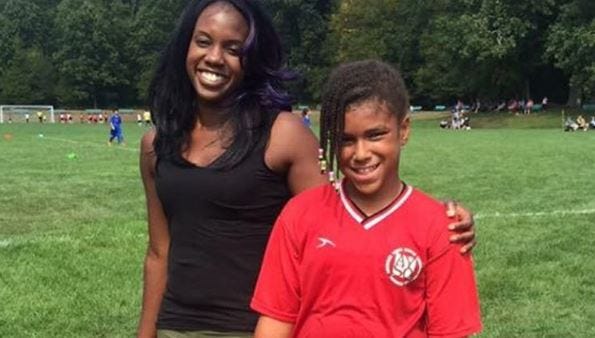9-year-old African American girl banned from soccer game because of hairstyle – ThinkProgress
She’s played AYSO soccer for six years, and her beads have never been an issue before.

Nine-year-old Aubrey Zvovushe-Ramos has played in the American Youth Soccer Organization (AYSO) for the past six years, and in most of her games she has worn the same hairstyle: small braids over to one side with beads at the end.
Until last weekend, that has never been a problem. But on Saturday, when Aubrey lined up with her Sapphires teammates in Monroe, Connecticut at the start of the game, the referee told her she wasn’t allowed to play in that game unless she took the beads out instantly.
“I felt she was singled out,” Aubrey’s mother, Amy Zvovushe-Ramos, told ThinkProgress. “She’s the only African American on the team. We go to the salon for an hour and a half — it’s not as simple as ‘pull the beads out.’”
Despite the initial controversy, Amy offered to compromise by tying Aubrey’s braids up tightly with a Scrunchie so they wouldn’t flap around as much. But that wasn’t satisfactory for the referee, and Aubrey remained on the bench the entire game, cheering on her teammates.
While AYSO rules specify that jewelry and metal and plastic hair clips are not permitted in games, there is nothing in the handbook about beads.
Amy reached out to AYSO over the weekend, but did not initially hear back from them. So, she decided to take to social media to share her story.
“All I wanted was an apology and for them to admit that they handled it incorrectly,” she said.
On Tuesday, Amy did hear back from the regional AYSO office, which claimed it had reviewed the policy and confirmed that beads are considered jewelry and are not allowed to be worn in games. However, when Amy and her husband pressed them on where that rule was located in the handbook, they admitted in emails reviewed by ThinkProgress that while it is “not specified” in the rules and regulations, there was “no question” in the national office that hair beads are considered jewelry.
AYSO did not immediately respond to ThinkProgress’ request for comment.
Amy says it’s certainly possible that this was a misunderstanding, that the referee simply did not understand African American hair was different and his request was not a quick fix. However, she says this incident does highlight the need for more diversity, or at least more diversity sensitivity training, in AYSO.
As Sharon Van Epps wrote in the Washington Post last month, the lack of diversity in all levels of soccer has been an issue in the United States for quite some time.
American youth soccer has evolved as a fixture of the suburbs, where economically advantaged families typically reside and where competitive team fees can run in the thousands of dollars annually. A 2014 University of Florida study found that overall sports participation rates for white children exceed that of every other ethnic group in America. Researchers and cultural critics agree: The inequities in youth sports revolve around money, and soccer is one of the least equitable. As Doug Andreassen, chairman of U.S. Soccer’s diversity task force, told the Guardian in June: “The system is not working for the underserved community. It’s working for the white kids.”
Aubrey has a younger sister in kindergarten who also loves soccer and frequently wears beads in her hair during games, and since Saturday, Amy has been working hard to get answers for herself and her two daughters.
“It’s rough for [Aubrey], she’s being strong but it was definitely a difficult weekend,” Amy said. “On Saturday night she couldn’t sleep. She still wants to play soccer, but I don’t know what to do moving forward.”



